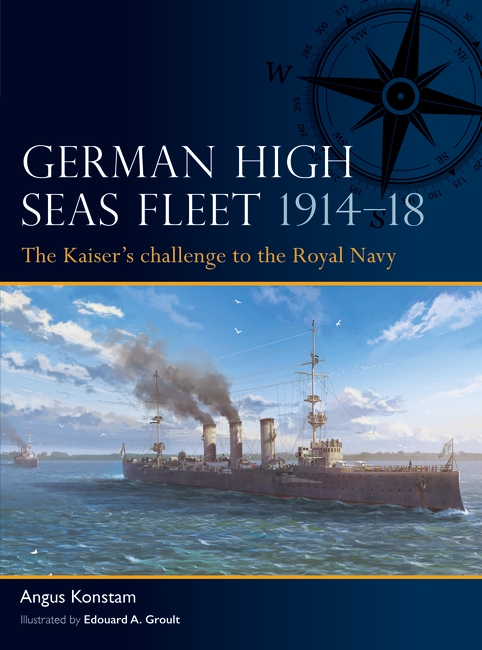
Learn about the introduction of Super Battleships to Germany's Fleet for September's Machine of the Month.
- The Kaiserliche Marine’s first dreadnoughts, or ‘super battleships’ as the Germans first called them, were the four vessels of the Nassau class. These had been designed by the navy’s chief architect Hans Bürkner, and laid down in secret during the summer of 1907. They entered service three years later.
- Bürkner placed greater emphasis on protection than speed or armament, and this established a path that would be followed by the fleet’s subsequent dreadnoughts.
- They used conventional reciprocating engines rather than the steam turbines used in Dreadnought, so these ships were slower than their British counterparts. Their 28cm (11in) guns were of a smaller calibre too, while the space taken up by machinery resulted in the ships’ awkward turret configuration. As a result, despite carrying 12 guns, they only had double the broadside firepower of their pre-dreadnought forebears.
- The next group, the three-funnel Helgoland class, represented an improvement. Internal space was better arranged, and although they shared the same problem with turret layout, they carried 30.5cm (12in) guns, had better underwater protection and were slightly faster. Although still coal-powered, auxiliary oil burners were installed in 1915.2 These entered service in 1911–12.
- The subsequent five-ship Kaiser class represented a significant leap forward. Not only were they fitted with steam turbines, giving them a slightly greater speed than their predecessors, but their 30.5cm guns were mounted on the centreline or echeloned amidships, which offered a greater broadside capability, despite carrying one turret fewer. They were also better protected, with a belt up to 35cm (14in) thick. These dreadnoughts entered service in 1913.
- The four König-class dreadnoughts which followed were similar, but enjoyed a much better turret layout, with only one centreline turret amidships, and two centreline turrets fore and aft, one superfiring over the other. Better gun elevation also meant increased range.
- The final dreadnoughts to join the fleet (although more had been planned) were the two Bayern-class ‘super dreadnoughts’ which were laid down before the war, and which entered service in 1916–17. These mounted eight 38cm (15in) guns in four twin turrets – two forward and two aft, with one superfiring over the other. Although not especially better armoured or faster than the previous German dreadnoughts, their firepower was equivalent to that of the Grand Fleet’s ‘fast battleships’, only with better protection and less speed.
- Germany’s first dreadnoughts were significantly better protected than their British contemporaries, with armour taking up 36 per cent of displacement, compared to 28 per cent in Dreadnought.
- The Nassau and Helgoland classes had KC armour belts 290–300mm thick, tapering towards either end, and an upper citadel belt 160–170mm thick. This compared favourably to their British counterparts. For the Kaiser, König and Bayern classes this belt was increased to 350mm, with a 200mm upper citadel, while the superstructure was also protected by 170mm of KC armour.
- All of these dreadnoughts employed the Böchung system, and the later classes had thicker armoured decks, up to 60mm in the Königs and Bayerns, which compared favourably to the latest British dreadnoughts.
- Germany was fortunate to have one of the leading steel producers in the world at its disposal. The family firm of Krupp, based in Essen, first made its mark producing high-quality steel which armed the 19th-century forces of Prussia. For a few years Krupp nickel steel enjoyed a qualitative edge, until their process was copied by others. By then, however, Krupp had developed a greatly improved steel, which would be used to protect the Kaiser’s dreadnoughts. Shortly after 1900, Krupp’s scientists discovered that by slightly altering the composition of their steel alloy, and selectively hardening one side in Krupp’s furnaces, the resulting steel plate was far more effective.
- The development of the Bayern class of dreadnoughts represented a major step forward for the Kaiserliche Marine. Arguably these were the best capital ships of the war, with a combination of good speed, excellent protection and a powerful main battery of eight 38cm (15in) guns. This photograph shows the forward turrets of Bayern, which became the fleet flagship after entering service two months after Jutland.
- One disadvantage of German capital ships compared to their British counterparts was speed. This was largely the result of the greater German emphasis on protection, which increased the weight of the ship being pushed through the water. It was also influenced by other things, including the inferiority of the brown lignite coal available to Germany, which burned less efficiently than the anthracite used in British ships. Also, German engines, despite often being copies of British ones, tended to produce a lower power output, which in turn meant a slower speed.
- When the König class of four dreadnoughts fully entered service in early 1915, these made up the V Division. At the same time the Kaiser-class dreadnoughts were redesignated as the VI Division.
- In early 1915, when the König-class dreadnoughts joined the fleet (becoming Division IV of Battle Squadron III), the Braunschweig-class pre-dreadnoughts Preussen and Lothringen were transferred into the Reserve Fleet, joining Squadron IV.
- The dreadnoughts of the High Seas Fleet, as well as the pre-dreadnought battleships and the battlecruisers, were designed to engage the enemy with their full broadsides.
- Each of the 16 dreadnoughts and six pre-dreadnought battleships in the line were normally spaced 500m apart – roughly 2½ cables, or a quarter of a nautical mile.


Comments
You must be logged in to comment on this post. Click here to log in.
Submit your comment